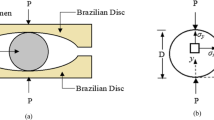Abstract
Scale effects in the mechanical behaviour of concrete are important phenomena and are the object of many studies internationally. The Laboratoire Central des Ponts et Chaussées has been working for several years on the scale effect on the distribution function of the tensile strength of concrete. Very many direct tensile tests have been performed on specimens of different volumes, made of concretes having different formulations. From these experimental investigations has been derived a general law that can be used to determine the distribution function (mean and standard deviation) of the tensile strength of the concrete versus the volume of the tensile specimen, for concretes having compressive strengths betwen 30 MPa and 130 MPa, from knowledge of just the compressive strength obtained on a standardized cylinder (in France) and the ratio of the volume of the tensile specimen to the volume of the coarsest aggregate in the concrete. It should be emphasized that this law is valid only if, on the one hand, the mode of preservation of the direct tensile specimens is identical to that of the compressive specimens and, on the other, the aggregates used in the concretes are common aggregates, which eliminates light aggregates and very hard aggregates with a high Young's modulus.
Resume
Les effets d'échelle dans le comportement mécanique du béton sont des phénomènes importants qui font l'object de nombreuses études au niveau international. Le Laboratoire Central des Ponts et Chaussées travaille depuis plusieurs années sur l'effet d'échelle existant sur la fonction de distribution de la résistance à la traction du béton. De très nombreux essais de traction directe ont ainsi été réalisés sur des éprouvettes de volume différent constituées de bétons de formulation également différente. De ces études expérimentales, il a été tiré une loi assez générale qui permet de déterminer, à partir de la seule connaissance de la résistance à la compression obtenue sur cylindre normalisé (en France), et du rapport du volume de l'éprouvette de traction au volume du plus gros grain de béton, la fonction de distribution (moyenne et écart-type) de la résistance à la traction du béton en fonction du volume de l'éprouvette de traction, cela pour des bétons dont la résistance à la compression est comprise entre 30 et 130 MPa. Il faut souligner que cette loi est valable uniquement si, d'une part le mode de conservation des éprouvettes de traction directe est identique à celui des éprouvettes de compression, et d'autre part les granulats utilisés dans les bétons sont des granulats courants, ce qui élimine les granulats légers et les granulats très durs et à fort module de Young.
Similar content being viewed by others
References
Rossi, P. and Richer, S., ‘Numerical modelling of concrete cracking based on a stochastic approach’,Mater. Struct. 20 (1987) 334–337.
Rossi, P and Piau, J. M., ‘The usefulness of statistical models to describe damage and fracture in concrete’, ‘CNRSNSF Workshop Strain Localization and Size Effect due to Cracking and Damage’, Cachan, France, edited by J. Mazars and Z. P. Bazant (Elsevier Applied Science, London, 1988) pp. 91–103.
Rossi, P., ‘Numerical modelling of the cracking of concrete using a non deterministic approach’, ‘Workshop on Fracture Toughness and Fracture Energy—Test Methods for Concrete and Rock’, Sendai, Japan, edited by H. Mihashi, H. Takahashi and F. H. Wittmann (A. A. Balkema, Rotterdam, 1988) pp. 301–312.
Bazant Z. P., ‘Size effects on fracture and localization: Aperçu of recent advances and their extension to simultaneous fatigue and rate-sensitivity’, ‘Conference on Fracture Processes in Concrete, Rock and Ceramics’, Noordwijk, The Netherlands, edited by J. G. M. Van Mier (E & FN Spon, London, 1991) pp. 417–429.
Nooru-Mohamed, M. B. and Van Mier, J. G. M., ‘Size effects in mixed mode fracture of concrete’,Ibid, pp. 461–471.
Attolou A., Belloc, A. and Torrenti, J. M., ‘Methodology for a new protection of concrete against desiccation’,Bull. Liaison LPC,164 (1989) 85–86 (in French).
Boulay, C. and Colson, A., ‘A concrete extensometer eliminating the influence of transverse strains on the measurement of longitudinal strains’,Mater. Struct. 14 (1981) 35–38.
Acker, P., Boulay, C. and Rossi, P., ‘On the importance of initial stresses in concrete and of the resulting mechanical effects’,Cement Concr. Res. 17 (1987) 755–764.
Wittmann, F. H., ‘Structure of concrete with respect to crack formation’, ‘Fracture Mechanics of Concrete’, edited by F. H. Wittmann (Elsevier, 1983) pp. 43–74.
Weibull, W., ‘A statistical theory of the strength of material’,Ing. vet. ak. Han. no. 151 (1939).
Rossi, P. and Chanvillard, G., ‘A new geometry of steel fibre for fibre reinforced concretes’, Proceedings of the International Workshop on High Performance Fibre Reinforced Cement, Mainz, Germany, 1991.
Author information
Authors and Affiliations
Rights and permissions
About this article
Cite this article
Rossi, P., Wu, X., Le Maou, F. et al. Scale effect on concrete in tension. Materials and Structures 27, 437–444 (1994). https://doi.org/10.1007/BF02473447
Issue Date:
DOI: https://doi.org/10.1007/BF02473447




